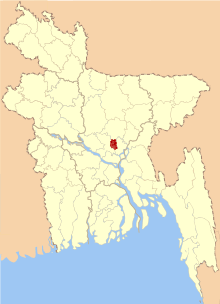Economy of Dhaka
Dhaka is the financial and the entertainment capital of Bangladesh. It accounts for up to 35% (130-168 billion USD Nominal GDP) of Bangladesh's economy. Dhaka's GDP is almost double to quadruple than the economy of neighbouring countries like Myanmar, Nepal, Sri Lanka etc. If Dhaka were a country than it would rank 50th economy in the list of countries GDP.[3][4] Dhaka is also home to major Bangladeshi industrial conglomerates such as Beximco Holdings Limited, Bashundhara Group, Jamuna Group, PRAN-RFL Group, BSRM and Defense Advancement Trading Company (DATCO).[5] Many foreign establishment such as GlaxoSmithKline, Heidelberg Cement, Reckitt Benckiser, HSBC, British American Tobacco, and Nestlé have their regional headquarters located in Dhaka.. Dhaka stock exchange is the 2nd biggest in the South Asian Nation. o
 The location of Dhaka on the map of Bangladesh | |
| Currency | Taka |
|---|---|
| FY20-21 | |
| Statistics | |
| GDP | $170 Billion (nominal, 2020) $340billion (PPP, 2020) |
| GDP rank | 1st |
GDP per capita | $7,400 (nominal, 2020) $9,800 (PPP, 2020) |
Population below poverty line | 09% |
| Unemployment | 4.0% (2020)[1] |
Average gross salary | 110000৳-BDT |
| Public finances | |
| Expenses | $805 million (DSCC + DNCC)[2] |
During the Mughal Era and Bengal Presidency, Dhaka has the biggest economy among the divisions in Bangladesh. Bengal presidency was the 50% contributor of Indian Mughal subcontinent. Dhaka's living standard was considered as like as London the wealthiest city of Europe in Mughal era.[6]
History
Due to its location right beside some main river routes, Dhaka was an important centre for business. Muslin fabric was produced and traded in this area.[7]
Italian traveller Niccolao Manucci came to Dhaka in 1662–63. According to him, there were only two kuthis (trading posts) – one of the English and the other of the Dutch. Ships were loaded with fine white cotton and silk fabrics.[8]

Sectors
| Top publicly traded companies in Dhaka for 2015 |
| Beximco |
| One Bank Limited |
| Al-Arafah Islami Bank Limited |
| Prime Bank Limited |
| United Airways |
| Mercantile Bank Limited |
| Beximco Pharma |
| Summit Power Limited |
The manufacture of brick in Dhaka's suburbs, which adds little to gross national product, adds significantly to PM2.5 air pollution.[9]
International trade and other sectors
Dhaka has historically derived significant revenue from International trade, Textile, Pharmachemical and financial institutions. The exports of goods made in Dhaka totalled approximately US$10 billion in 2012, with a rapid growth in Pharmachemical, and IT with 15.68% and 7.28% growth.
See also
References
- "Asian Metropolis: Dhaka" (PDF). Urban. Retrieved 29 October 2014.
- Mollah, Shahjahan (6 July 2014). "Budget for split DCCs Monday, Tuesday". Banglanews24.com. Archived from the original on 10 July 2014. Retrieved 18 February 2015.
For the fiscal year 2014-15, the DSCC budget will stand at Tk 1,800 crore while Dhaka North City Corporation would be announced its budget of Tk 2,000 crore.
- Rezaul Karim (24 February 2017). "Dhaka's economic activities unplanned: analysts". The Daily Star.
- Cambridge Centre for Risk Studies at the University of Cambridge Judge Business School. "Dhaka Factsheet". Lloyd's City Risk Index 2015–2025. Lloy'ds. Retrieved 25 November 2016.
- "Dhaka Improving Living Conditions of the Poor". Retrieved 29 October 2014.
- Kabir, Anisul; Parolin, Bruno. "PLANNING AND DEVELOPMENT OF DHAKA – A STORY OF 400 YEARS" (PDF). fau.usp.br. Archived from the original (PDF) on 10 January 2017. Retrieved 30 December 2015.
- Akter, Sayeeda (3 March 2010). "Economic life carved in history". The Daily Star. Retrieved 30 December 2015.
- Aniruddha Ray. "Manucci, Niccolao". Banglapedia. Retrieved 29 May 2015.
- Sohara Mehroze Shachi (5 September 2018). "Bangladesh's Air Pollution Problem Grows, Brick by Brick". Undark. Retrieved 7 September 2018.
The kiln operations alone — while representing just 1 percent of the country’s GDP — generate nearly 60 percent of the particulate pollution in Dhaka, according to Bangladesh’s Department of Environment (DOE).